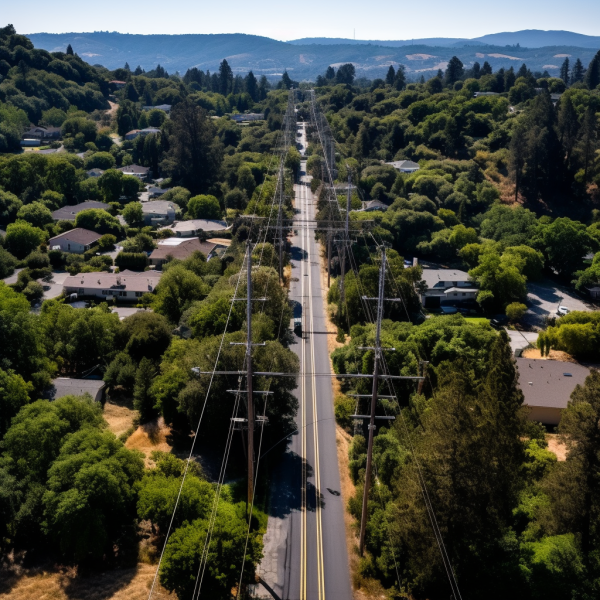‘This is hell’: Repeat outages mar PG&E’s wildfire safety shift from tree trimming to circuit breakers

Laurel Adams Ferns awoke Monday to find her Walnut Creek home without power, necessitating a trip to a nearby cafe for an internet connection to get through her fourth outage in less than a month, each lasting more than 10 hours.
Pacific Gas & Electric Co., which has been blamed for devastating wildfires caused by power lines in recent years and is under pressure to improve safety, has launched a new strategy this year that shifts the focus from increased tree trimming near its equipment to advanced circuit-breaker technology. According to the utility, the change reduced fire risk while having little additional impact on most customers. Customers, however, have complained that the rollout has been plagued by repeated outages — and one of PG&E’s own reports to California regulators shows a spike in customer outages last year as the program was launched.
“For those of us who work remotely,” Ferns, a lawyer, said, “this is hell, let alone factoring in how many times since this new’strategy’ went into place that I have had to throw out everything from my refrigerator.”
PG&E acknowledged that its new approach has increased “the number of customers impacted” and that it is working to fine-tune it to improve reliability.
“PG&E is making the electric system safer and stronger for our communities,” according to a statement from the utility. “We understand how difficult it was for the customers who did experience outages, which is why we are constantly looking for ways to reduce the impact of power outages on our customers.”
Enhanced Powerline Safety Settings, or EPSS, are at issue, in which circuit breakers automatically cut power to a block of customers within a tenth of a second when there is a fault, such as a branch falling on a power line. It was introduced by PG&E in 2021 and was completed last year in and around high-risk areas such as the East Bay, North Bay, Peninsula, South Bay foothills, and Santa Cruz Mountains.
Last month, the utility informed state regulators that the EPSS program in 2022 would reduce the number of fire ignitions by 68% over previous year averages, compared to 7% under its vegetation management program.
However, a series of power outages this summer prompted some residents to launch online petitions, which drew the attention of some local officials. Following Monday’s outages, the city of Lafayette contacted the utility and requested that company representatives attend a City Council meeting later this month to provide updates on the situation. PG&E is planning community events in both San Jose and Los Gatos to answer questions.
The complaints have not gone unnoticed by the agencies in charge of PG&E. The troubled utility, which serves more than 5 million people in most of Northern California, is facing questions from state officials as it seeks approval of an updated wildfire safety plan.
The California Public Utilities Commission fined the utility a record $1.97 billion in 2020 for a series of deadly Northern California wildfires caused by its equipment in 2017 and 2018. Most recently, PG&E reached a $50 million settlement with Shasta County authorities over the deadly 2020 Zogg Fire, which was sparked by a tree striking power lines.
The utility said in a mandated response this week to the state Office of Energy Infrastructure Safety, which asked PG&E to revise its most recent wildfire plan, that data show the EPSS technology did not adversely affect outages for most customers. The response is being reviewed by the agency.
According to PG&E’s response, of the 1.8 million customers on EPSS-protected circuits in 2022, 58% had no outages from the technology last year, and 26% had no more than two, with the average outage shrinking to under three hours. According to the utility, the majority of customers “experienced service reliability consistent with systemwide performance.”
However, in its 2022 annual electric reliability report to the CPUC on July 15, PG&E stated that its “reliability metrics were negatively affected as PG&E implemented Enhanced Powerline Safety Settings” and that “these wildfire mitigation efforts have resulted in customers experiencing more and longer sustained outages.” According to PG&E, the “electric system also experienced new and different stresses due to load shifts as many Californians continued to work remotely in 2022,” as a result of the COVID-19 pandemic.
The reliability report found that annual customer outage frequency was up 44%, outage duration was up 19%, and annual minutes out were up 71% in 2022 compared to the previous five years on average, with EPSS frequently cited as a factor.
It was even worse in several areas of the greater Bay Area, including Contra Costa County and the Santa Cruz Mountains.
That was only a year ago. Residents have complained that outages have been frequent this year, rain or shine. Moraga experienced outages on July 13, 14, and 20 as well as August 3, 5, and 7. Los Gatos lost power on July 17, July 20, and August 7.
PG&E stated that it has been working on sensitivity settings and other system tweaks to reduce unnecessary outages, and that outages are down more than 20% this year compared to the same period last year.
Kathryn Hayes of Boulder Creek said she and her husband experienced five power outages from June 1 to August 1.
“We were sold this program under the guise of safety.” “All I know is that it’s extremely inconvenient and upsetting for me as a customer,” Hayes said. “You never know what will happen next.” We have frequent and lengthy power outages during the winter. In the summer, we now have frequent and sometimes lengthy power outages.”
She and her neighbors believe PG&E overloaded the circuit breakers. She and her husband purchased a generator a few weeks ago, but with so many blackouts, they are unsure how long they will be able to stay in their Santa Cruz Mountains home.
“There has to be a better solution,” Hayes contended. “They applaud themselves for making us ‘safer,’ but all they’re really doing is making us suffer.”






